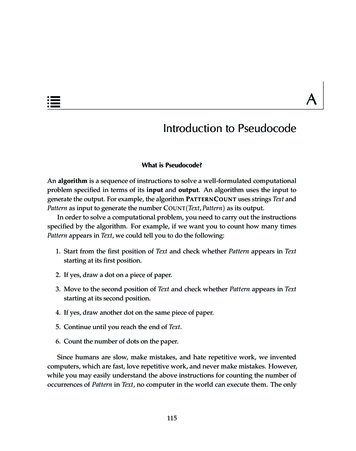
Transcription
AIntroduction to PseudocodeWhat is Pseudocode?An algorithm is a sequence of instructions to solve a well-formulated computationalproblem specified in terms of its input and output. An algorithm uses the input togenerate the output. For example, the algorithm PATTERN C OUNT uses strings Text andPattern as input to generate the number C OUNT (Text, Pattern) as its output.In order to solve a computational problem, you need to carry out the instructionsspecified by the algorithm. For example, if we want you to count how many timesPattern appears in Text, we could tell you to do the following:1. Start from the first position of Text and check whether Pattern appears in Textstarting at its first position.2. If yes, draw a dot on a piece of paper.3. Move to the second position of Text and check whether Pattern appears in Textstarting at its second position.4. If yes, draw another dot on the same piece of paper.5. Continue until you reach the end of Text.6. Count the number of dots on the paper.Since humans are slow, make mistakes, and hate repetitive work, we inventedcomputers, which are fast, love repetitive work, and never make mistakes. However,while you may easily understand the above instructions for counting the number ofoccurrences of Pattern in Text, no computer in the world can execute them. The only115
W H I C H D N A PA T T E R N S P L AY T H E R O L E O F M O L E C U L A R C L O C K S ?reason you can understand them is because you have been trained for many years tounderstand human language. For example, we didn’t specify that you should startfrom a blank piece of paper without any dots, but you assumed it. We didn’t explainwhat it means to “reach the end of Text”; at what position of Text should we stop?Because computers do not understand human language, algorithms must be rephrasedin a programming language (such as Python, Java, C , Perl, Ruby, Go, or dozens ofothers) in order to give the computer specific instructions. However, we don’t want todescribe algorithms in a specific language because it may not be your favoriteOur focus is on algorithmic ideas rather than on implementation details, which iswhy we will meet you halfway between human languages and programming languagesby using pseudocode. By emphasizing ideas rather than implementation details, pseudocode is able to describe algorithms without being too formal, ignoring many of thetedious details that are required in a specific programming language. At the same time,pseudocode is more precise and less ambiguous than the instructions we gave abovefor counting a pattern in a text.For example, consider the following pseudocode for an algorithm called D ISTANCE,whose input is four numbers (x1 , y1 , x2 , y2 ) and whose output is one number d. Canyou guess what it does?DISTANCE(x1 , y1 , x2 , y2 )d(xx1 )2 (y2p2ddreturn dy1 ) 2The first line of pseudocode specifies the name of an algorithm (D ISTANCE), followedby a list of arguments that it requires as input (x1 , y1 , x2 , y2 ). Subsequent lines containthe statements that describe the algorithm’s actions, and the operation return reportsthe result of the algorithm.We can invoke an algorithm by passing it the appropriate values for its arguments.For example, D ISTANCE (1, 3, 7, 5) would return the distance between points (1, 3) and(7, 5) in two-dimensional space, by first computingd71)2 (53)2 40and then computingdp11640 .
W H I C H D N A PA T T E R N S P L AY T H E R O L E O F M O L E C U L A R C L O C K S ?The pseudocode for D ISTANCE uses the concept of a variable, which contains somevalue and can be assigned a new value at different points throughout the course of analgorithm. To assign a new value to a variable, we use the notationab,which sets the variable a equal to the value stored in variable b. For example, in thepseudocode above, when we compute D ISTANCE (1, 3, 7, 5), d is first assigned the valuep(7 1)2 (5 3)2 40 and then is assigned the value 40.Furthermore, we can use any name we like for variable names. For example, thefollowing pseudocode is equivalent to the previous pseudocode for D ISTANCE.DISTANCE(x, y, z, w)abracadabra(z x)2 (w y)2pabracadabraabracadabrareturn abracadabraWhereas computer scientists are accustomed to pseudocode, we fear that some biologistsreading this book might decide that pseudocode is too cryptic and therefore useless.Although modern biologists deal with algorithms on a daily basis, the language theyuse to describe an algorithm may be closer to a series of steps described in plain English.Accordingly, some bioinformatics books are written without pseudocode. Unfortunately, this language is insufficient to describe the complex algorithmic ideas behindvarious bioinformatics tools that biologists use every day.To be able to explain complex algorithmic ideas, we will need to delve deeper intothe details of pseudocode. As a result, you will be able not only to understand thealgorithms in this book, but use pseudocode to design your own algorithms!Nuts and Bolts of PseudocodeWe have thus far described pseudocode only superficially. We will now discuss someof the details of pseudocode that we use throughout this book. We will often avoidtedious details by specifying parts of an algorithm in English, using operations that arenot listed below, or by omitting noncritical details.117
W H I C H D N A PA T T E R N S P L AY T H E R O L E O F M O L E C U L A R C L O C K S ?if conditionsThe algorithm M INIMUM 2 shown below has two numbers (a and b) as its input and asingle number as its output. What do you think that it does?MINIMUM2(a, b)if a breturn belsereturn aThis algorithm, which computes the minimum of two numbers, uses the followingconstruction:if statement X is trueexecute instructions Yelseexecute instructions ZIf statement X is true, then the algorithm executes instructions Y; otherwise, it executesinstructions Z. For example, M INIMUM 2 (1, 9) returns 1 because the condition “1 9”is false.The following pseudocode computes the minimum of three numbers.MINIMUM3(a, b, c)if a bif b creturn celsereturn belseif a creturn aelsereturn cWe may also use else if, which allows us to consider more than two different possibilities in the same if statement. For example, we can compute the minimum of three118
W H I C H D N A PA T T E R N S P L AY T H E R O L E O F M O L E C U L A R C L O C K S ?numbers as follows.MINIMUM3(a, b, c)if a c and b creturn celse if a b and c breturn belsereturn aBoth of these algorithms are correct, but below is a more compact version that uses theM INIMUM 2 function that we already wrote as a subroutine, or a function that is calledwithin another function. Programmers break their programs into subroutines in orderto keep the length of functions short and to improve readability.MINIMUM3(a, b, c)if a breturn MINIMUM2(b, c)elsereturn MINIMUM2(a, c)STOP and Think: Can you rewrite M INIMUM 3 using just a single line of pseudocode?EXERCISE BREAK: Write pseudocode for an algorithm M INIMUM 4 that computes the minimum of four numbers.Sometimes, we may omit the “else” statement.for loopsConsider the following problem.119
W H I C H D N A PA T T E R N S P L AY T H E R O L E O F M O L E C U L A R C L O C K S ?Summing Integers Problem:Compute the sum of the first n positive integers.Input: A positive integer n.Output: The sum of the first n positive integers.If n were a fixed number, then we could solve this problem using our existing framework. For example, the following program S UM 5 returns the sum of the first fiveintegers (i.e., 1 2 3 4 5 15).SUM5( )sum0i1sumsum iii 1sumsum iii 1sumsum iii 1sumsum iii 1sumsum ireturn sumWe could then write S UM 6, S UM 7, and so on. However, we cannot endorse this programming style! After all, to solve the Summing Integers Problem for an arbitraryinteger n, we will need an algorithm that takes n as its input. This is achieved by thefollowing algorithm, which we call G AUSS.GAUSS(n)sum0for i1 to nsumsum ireturn sum120
W H I C H D N A PA T T E R N S P L AY T H E R O L E O F M O L E C U L A R C L O C K S ?G AUSS employs a for loop that has the following format:for ia to bexecute XThis for loop first sets i equal to a and executes instructions X. Afterwards, it increases iby 1 and executes X again. It repeats this process by increasing i by 1 until it becomesequal to b, when it makes a final execution of X. That is, i varies through the valuesa, a 1, a 2, . . . , b 1, b during execution of the loop.while loopsA different way of summing the first n integers, called A NOTHER G AUSS, is shownbelow.ANOTHERGAUSS(n)sum0i1while i nsumsum iii 1return sumThis algorithm uses a while loop having the following format:while statement X is trueexecute YThe while loop checks condition X; if X is true, then it executes instructions Y. Thisprocess is repeated until X is false. (Note: if X winds up always being true, then thewhile loop enters an infinite loop, which you should avoid at all costs, because youralgorithm will never end.) In the case of A NOTHER G AUSS, the loop stops executingafter n trips through the loop, when i eventually becomes equal to n 1 and the numbers1 through n have been added to sum.121
W H I C H D N A PA T T E R N S P L AY T H E R O L E O F M O L E C U L A R C L O C K S ?Recursive algorithmsBelow is yet another algorithm solving the Summing Integers Problem.RECURSIVEGAUSS(n)if n 0sumRECURSIVEGAUSS (nelsesum0return sum1) nYou may be confused by the fact that R ECURSIVE G AUSS (n) calls R ECURSIVE G AUSS (n1) as a subroutine. So imagine that you are computing the sum of the first 100 positiveintegers, but you are lazy and ask your friend to compute the sum of the first 99 positiveintegers for you. As soon as your friend has computed it, you will simply add 100 tothe result, and you are done! Yet little do you know that your friend is just as lazy, andshe asks her friend to compute the sum of the first 98 integers, to which she adds 99and then passes to you. The story continues until a friend is assigned 1. Although everyindividual in this chain of friends is lazy, the group is nevertheless able to compute thesum.R ECURSIVE G AUSS presents an example of a recursive algorithm, which subcontracts a job by calling itself (on a smaller input).EXERCISE BREAK: Can you write one line of pseudocode solving the SummingIntegers Problem?You have undoubtedly been wondering why we have named all these summing algorithms “Gauss”. In 1785, a primary school teacher asked his class to sum the integersfrom 1 to 100, assuming that this task would occupy them for the rest of the day. Hewas shocked when an 8 year old boy thought for a few seconds and wrote down theanswer, 5,050. This boy was Karl Gauss, and he would go on to become one of thegreatest mathematicians of all time. The following one-line algorithm implements hisidea for solving the Summing Integers Problem. (Why does it work?)GAUSS(n)return (n 1) · n/2122
W H I C H D N A PA T T E R N S P L AY T H E R O L E O F M O L E C U L A R C L O C K S ?ArraysFinally, when writing pseudocode, we may also use an array, or an ordered sequence ofvariables. We often use a single letter to denote an array, e.g., a ( a1 , a2 , . . . , an ).EXERCISE BREAK: Consider the algorithm following this exercise. What doesit do?RABBITS(n)a11a21for i3 to naiai 1 ai2return aR ABBITS (n) computes the first n Fibonacci numbers and places them in an array. Whydo you think that we called it R ABBITS?123
A Introduction to Pseudocode What is Pseudocode? An algorithm is a sequence of instructions to solve a well-formulated computational problem specified in terms of its input and output.An algorithm uses the input to generate the output. For example, the algorithm PATTERN COUNTuses strings Text and Patt










